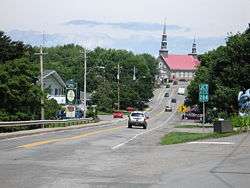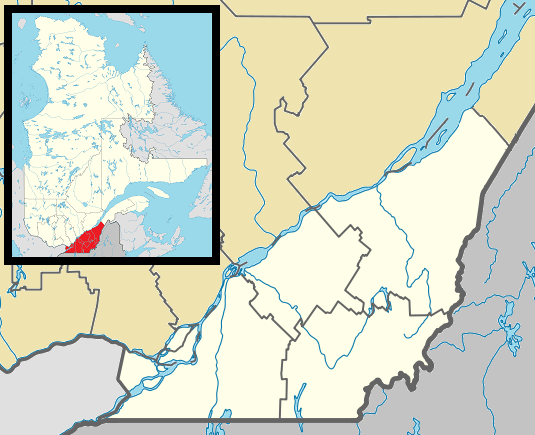Saint-Jean-Port-Joli, Quebec
| Saint-Jean-Port-Joli | |
|---|---|
| Municipality | |
 | |
 Location within L'Islet RCM. | |
 Saint-Jean-Port-Joli Location in southern Quebec. | |
| Coordinates: 47°13′N 70°16′W / 47.217°N 70.267°WCoordinates: 47°13′N 70°16′W / 47.217°N 70.267°W[1] | |
| Country |
|
| Province |
|
| Region | Chaudière-Appalaches |
| RCM | L'Islet |
| Constituted | July 1, 1855 |
| Government[2] | |
| • Mayor | Jean-Pierre Dubé |
| • Federal riding |
Montmagny—L'Islet— Kamouraska—Rivière- du-Loup |
| • Prov. riding | Côte-du-Sud |
| Area[2][3] | |
| • Total | 240.90 km2 (93.01 sq mi) |
| • Land | 68.95 km2 (26.62 sq mi) |
| Population (2011)[3] | |
| • Total | 3,304 |
| • Density | 47.9/km2 (124/sq mi) |
| • Pop 2006-2011 |
|
| • Dwellings | 1,658 |
| Demonym(s) | Port-Jolien(ne) |
| Time zone | EST (UTC−5) |
| • Summer (DST) | EDT (UTC−4) |
| Postal code(s) | G0R 3G0 |
| Area code(s) | 418 and 581 |
| Highways |
|
| Website |
www portjoli |
Saint-Jean-Port-Joli is a village in the Regional County Municipality of L'Islet within the Chaudière-Appalaches region of Quebec, Canada. It is located on the south shore of the Saint Lawrence River and is the county seat. The village is located off the Trans-Canada Highway, Autoroute 20. Route 132 passes through the town.
It is known for its craftspeople and artists, especially in the fields of wood carving and sculpture. There are also several well-reputed restaurants.
History

The village takes its name from the seigneury of Port-Joly, which was established in 1677. The Parish of St-Jean-Port-Joli was canonically established in 1721. The church, on which construction began in 1779, has unique architecture and houses many sculptures. The municipality was created in 1845 and became part of the RCM of L'Islet in 1847. In 1855, it became a parish municipality, and in 1857 it was split into the municipalities of St-Jean-Port-Joli and Saint-Aubert.[4]
Like most other villages that lie in the Côte-du-Sud region between Rivière-Ouelle and Beaumont, most of its houses were burned down in September 1759. Under the orders of British general James Wolfe, the Fraser Highlanders regiment attacked the area during the Conquest of 1760 during the French and Indian War.
The tradition of wood carving began in the early 20th century with the Bourgault brothers, Médard, Jean-Julien and André.
Tourist attractions
Despite its small population, the village is a relatively active tourist stop in the region, primarily due to the abundance of artesian wood carvers and cultural events. The village also includes a marina with access to the Saint Lawrence River at the site of the old wharf.
St-Jean-Port-Joli was awarded with the title of cultural capital of Canada in 2005.
Biennial sculpture festival
Festival of sailors' songs
This festival highlights many aspects of the village's maritime heritage, legends, and songs. Also included in the weekend-long event is a dinner, workshops, literary contest, sailboat race, market, films, and expositions.[6]
The autumn violins
This is an annual festival of music that has taken place since 1998. Every year in the month of September, fiddlers gather and play music from a wide variety of genres.[7]
The winter festival
In the month of February, the Trois-Bérets park invites ice sculptors from around the world to display their talent. Additionally, the festival contains activities for the family in the daytime, such as helicopter rides, and concerts at night.[8]
See also
References
- ↑ Reference number 56895 of the Commission de toponymie du Québec (French)
- 1 2 Geographic code 17070 in the official Répertoire des municipalités (French)
- 1 2 "(Code 2417070) Census Profile". 2011 census. Statistics Canada. 2012.
- ↑ Toponymie : Saint-Jean-Port-Joli
- ↑ "La Biennale de sculpture de Saint-Jean-Port-Joli".
- ↑ "Fête des chants de marins" (in French).
- ↑ "Les Violons d'Automne" (in French).
- ↑ "La Fête d'hiver de St-Jean-Port-Joli" (in French).
External links
 |
Petite-Rivière-Saint-François Saint Lawrence River |
L'Isle-aux-Coudres Saint Lawrence River |
Saint-Roch-des-Aulaines |  |
| Saint-Antoine-de-l'Isle-aux-Grues / Saint Lawrence River | |
Sainte-Louise | ||
| ||||
| | ||||
| L'Islet | |
Saint-Aubert |